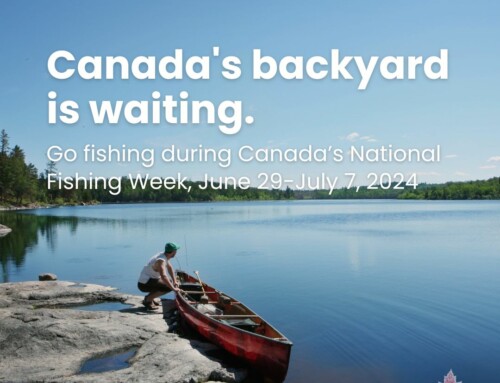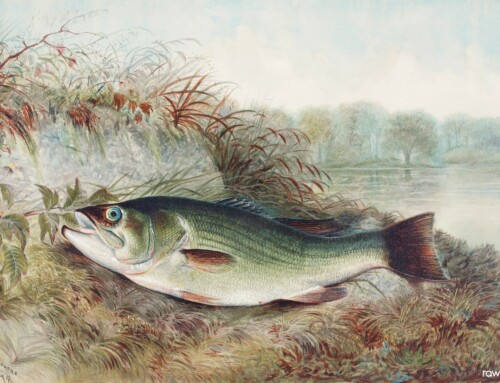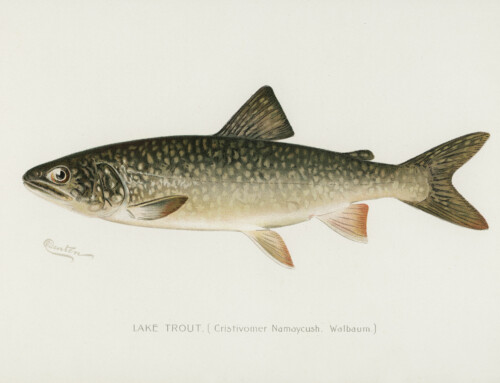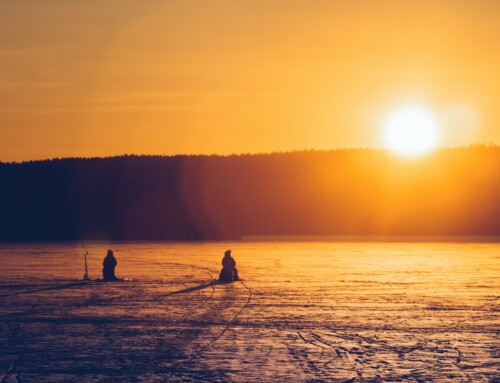Originally Published by Outdoor Canada, November 4, 2015
By Gord Pyzer
Fall favourites
Secret late-season baits and techniques
In fall, the fish are feeding frantically, making it a great time for big fish. Here are five of my favourite fall patterns for largemouth and smallmouth bass, northern pike, yellow perch and crappies.
1. Largemouth bass
Football jigs & craws

Autumn is football season for largemouth, not only because the fish resemble overinflated pigskins, but because football jigs are often the best way to catch them. In the fall, many of the fish that spent the summer tucked up in the shade of the thickest, gnarliest, out-of-reach jungles of cabbage, coontail and milfoil pull out to scrounge for crayfish on nearby rocky shorelines.
Secondary points lying inside bays and coves are typically the first stop on the fall bass migration toward the main lake, but by Thanksgiving, the primary lead-in points are most worthy of your attention. The slow and steady build up of fish simply gets better and better until ice and snow finally force you to put the boat away for the season.
That largemouth crave crayfish in the fall tells you everything you need to know about why football jigs are so superior. The bulging head does many important things—from imparting a subtle action as you drag it over the stones to adding an attractive skull to your soft-plastic trailer. As well, football jigs roll along with the hook pointed up, which considerably reduces snags without preventing solid hooksets.

I almost always opt morefor a Terminator or Freedom Tackle football jig (above) that weighs an eighth to a quarter ounce more than you’d use during summer. Why? Fall largemouth rarely hit your bait as it descends. They’re feeding off the bottom, so you want your jig to sink fast and to maintain contact with the bottom. A slow to moderate bottom-bumping retrieve, with plenty of pauses, is usually ideal, although a heavier head lets you speed up slightly as you search the bottom for fish.
As for trailers, you can tip your jig with a lizard, worm, creature bait, minnow or grub, but why bother when crayfish imitations imitate lobster dinner so well? Some of my favourites are the Trigger X Flappin’ Craw (below), PowerBait Chigger Craw and NetBait Paca Craw.

Remember, this is football not ballet, so leave the spinning gear in the rod locker. I like a seven-foot to 7′ 4″ medium-action rod if it’s on the stiff side, or a medium-heavy-action if it’s limper. And you’ll need a reel with a 6:1 or faster ratio for quickly tackling any bass that picks up a fumble and runs toward the boat trying to score a touchdown. For maximum sensitivity and hooksetting power, spool the reel with 30- to 40-pound braided line and attach a 15- to 17-pound fluorocarbon leader.
2. Northern pike
Jerkbaits & swimbaits

How can you not like catching pike in the fall? The big toothy critters that escaped detection over the summer, loafing in much deeper water than most anglers are accustomed to fishing, are now moving shallow once again. But unlike any other times of the year, they’re travelling in groups of big fish. That means when you find one knee-knocking monster, you can be almost certain others are nearby.
The obvious contact spots are main-lake rocky shoals and points, although not all will produce pike. The best ones feature relatively sharp breaks and drop-offs into deep water; position your boat in 15 to 20 feet of water so you can easily cast up shallow.
The wind can be an astonishing ally at this time of year. Indeed, take two rocky structures of equal size, and the one exposed to the wind will be the high-stakes table, so to speak. That’s because the swirling water reduces light penetration, which is extremely important on bright Indian summer days, allowing the pike to comfortably ambush forage.
More importantly, however, wind makes for a mind-altering pike prescription that spellbinds the fish and kicks their metabolism into high gear. On a lake you’ve never fished before, you could do much worse than run-and-gun as many main-lake shoals and points as possible on the windy side of the lake.
In terms of bait, there’s really no need to stress. Fall pike are prodigious predators looking for meaty meals, so just dish up what they want. Typically, they’re feeding on hordes of yellow perch and schools of high-protein ciscoe (also known as lake herring and tullibee) that are coming in from deep water to spawn.

Ideal are five- and six-inch crankbaits that are slightly larger than what you’d throw for bass yet smaller than what you’d select for muskies. Rapala’s 5½-inch, 1 5/8-ounce, Super Shad Rap (above) is the single-best crankbait I’ve used. Also use larger soft-plastic paddletails pinned to ½-, ¾- and one-ounce jigheads. Five- and six-inch soft-plastic swimbaits with internal lead heads, such as Storm’s WildEye Swim Shads (below), kick butt in the fall.

You’ll want to throw these baits using seven- to 7½-foot, medium-heavy-action baitcasting rods. Bass flipping sticks work well in a pinch, as do light-action muskie bucktail rods. Spool your baitcaster with 30- to 50-pound-test braided line and always tip it with a quality titanium or muskie-style fluorocarbon leader.
Normally, you would want to reel in quickly after you’ve retrieved 50 to 60 per cent of your line; that way, you maximize the first half of your presentation, which typically produces more than 75 per cent of the fish. But in the fall, pike will follow your baits out off the edge of the structure and into no man’s land, all the way back to the boat. And regardless of the bait you’re using, therefore, be sure to occasionally stop retrieving, even for a second or two, so that the lure either suspends or falls. This slight, subtle change will trigger the vast majority of strikes.
3. Smallmouth bass
Umbrella rigs

The hottest bait to hit the U.S. bass scene over the past few years has undoubtedly been the umbrella rig, which is also known as the Alabama rig. So many upstarts began winning big-cash tournaments with the lure, in fact, that it was quickly banned from elite competition. Here in Canada, however, interest in the rig fizzled out after it seemingly failed to live up to its advance billing.
For the uninitiated, an umbrella rig is a fanned-out array of five or so wires, fixed at the end where you tie on your line. Each wire ends with a soft-plastic swimbait, so the overall effect mimics a school of baitfish. And while umbrella rigs look awfully garish, the bass appear to be so mesmerized by the baits that they don’t see the wires. (Be sure to check that the multi-hook rig does not contravene your local fishing regulations.)
When umbrella rigs exploded onto Canada’s bass-fishing scene, many anglers excitedly tied one on, only to soon put it away when it failed to produce more or bigger bass. The trouble was, most of this first-time experimentation took place in the spring and summer on lakes where crayfish dominated the smallmouth’s diet. With the fish looking down for dinner—not five to 10 feet above their heads—the rig failed to produce.
Fortunately, a few die-hard anglers continued to experiment into the fall on lakes where suspended pelagic baitfish, especially rainbow smelts, dominate the forage. Bingo! The Canadian connection was born.

An umbrella rig (above) comes into its own when the water temperature finally dips for good below the 16°C mark, and they only get better the farther the temperature drops. It also works best when you use jig heads that match the size, shape and colour of your lake’s forage fish. Most effective are ⅛- to ⅜-ounce jigs with three- to six-inch swimbaits, such as Bass Magnet Lure’s Shift’R Shad, Reaction Innovations’ Skinny Dipper, PowerBait’s Split Belly and Trigger X’s Slop Hopper.
Once your sonar reveals smallmouth on a structure, pitch out the rig using a sidearm lob. You’ll want a 7½- to eight-foot, heavy-action baitcasting rod with tip action in the upper one-third of the rod. A flippin’ stick will work in a pinch, especially when you’re using lighter jigs pinned to smaller swimbaits. Always spool your baitcaster with at least 50-pound-test braided line to accommodate casting the heavy rig. Braided line’s thin diameter allows for long pitches, while the low stretch greatly helps in setting the hooks at a distance.
After casting out the rig, count down to the zone the fish are using—either close to the bottom or suspended in the water column—and begin a slow, steady retrieve. To trigger strikes, pause occasionally so the rig stops and sinks a few inches, then snap it back up to attention.
4. Yellow perch
Drop-shot rigs

“They look like pigs,” my fishing buddy Jimmy Valeriote says of yellow perch, “because they eat like pigs.” The southern Ontario perch-meister divides his fishing time between Lake Erie and Lake Simcoe, two of the planet’s finest perch fisheries. And he says fall is the time for both big fish and big schools.
“They’re always sliding in or out, looking for the cool-water transition,” Valeriote says. Accordingly, he pays special attention to wind direction, especially on Erie. “The ideal situation is a north offshore wind that sweeps the warm surface water out into the middle of the lake, while pulling the cooler water up from the bottom and into the shallows.”
Valeriote says Erie is strictly a bait bite, owing to the huge round goby population. “If you’re not using minnows, you’re going to get out-fished 10 to one by someone who is,” he says. “It’s just crazy how many four-inch gobies a 12- to 15-inch perch will cough up. When I look in the livewell at the end of the day, it’s littered with gobies. It looks like a bomb went off.” That’s not the case with Lake Simcoe or the other inland lakes he fishes, however, where small spoons and soft-plastics produce as well as live bait.
On Simcoe, Valeriote will typically offer the perch a choice for dinner, using a drop-shot rig with a small tube jig serving as the weight on the end of the line. A foot or above that, he tips a #4 Tru-Turn hook with an emerald shiner (below) . On Lake Erie, he sticks with a drop-shot rig featuring a ⅜- to one-ounce sinker—depending on the depth and current speed—with his hook only four inches above it. “The reason I place the hook so close to the sinker is because gobies never leave the bottom,” he says.

Valeriote routinely cuts his shiners in half so they leave behind a juicy scent trail. “When the water is clear, it’s less important,” he says, “but when there’s only four inches of visibility, the perch go into taste mode using the current to home into your bait.” Indeed, Valeriote says odour can be such a powerful draw that when two or three friends accompany him, the group typically catches more perch than when he fishes alone.
As for prime perch places, Valeriote says locating isolated patches of gravel on an otherwise soft mud or clay bottom can spell instant success. “In the old days, before we had the Spot-Lock and i-Pilot features on our electric trolling motors to hold us on a location, we’d double anchor so the boat didn’t move,” he says. “I’ll never forget seeing all the gravel on the discs when we pulled them up.”
You might think that with so many giant yellow perch piled under his boat, Valeriote would favour light, finesse-style gear to trick them, but that’s not the case. Instead, he spools his spinning reels with thin, 12- to 20-pound-test braid or gel-spun line. Using a small barrel swivel, he then attaches a three- to four-foot length of 12-pound-test fluorocarbon as a leader. “It’s a pack mentality in the fall,” he says. “When you’re handling as many fish as I am, you don’t break them off with that leader and it doesn’t bother the perch. They just want to eat meat.”
The way Valeriote sees it, fall fishing is all about capitalizing on opportunities and keeping the fish around. “You can go more finesse if you like,” he says, “but you’re not going to catch any more fish.”
5. Crappies
Doubled-up spoons

When most anglers see fall crappies on their sonar screen—either relating to a deep weed edge or spread across the basin bottom of an isolated pocket—they fish a traditional small jig tipped with either a soft-plastic dressing or a lively minnow. If the fish turn it down, most anglers will also decide to then put on an even tinier jig and fish it slower. Not me. I’ll fire up the fish instead by rapidly dancing a spoon above their heads—my two favourites are venerable Williams Wabler (below left)and the innovative Freedom Minnow (below right).

You can often get crappies so excited by engaging their competitive spirit, in fact, that after you’ve landed a couple of fish, the ones left below will quickly rise up to intercept your bait as soon as it hits the water. It’s as though they’re shouting, “Me too, me too!”
To properly work the spoons, I use light three-, four- or five-pound-test gel-spun line such as Sufix Fuse tipped with a foot of similar-strength Maxima monofilament as the leader. And here’s a secret: I double up my Wablers to get the presentation down faster.
To double up, I take two identical size W20, W30 or W40 Wablers and remove the O-rings and hooks. I then sandwich them together and reattach the O-rings and one hook. This doubles the offering’s weight without changing its crappie-appealing size. It also lets me customize the set-up, mixing and matching among the Wabler’s many different colours and finishes.
When I get a school of fish assembled and fired up using, say, a sandwiched pair of 1¼-inch W20 Wablers weighing a fifth of an ounce, I’ll switch over to an even bigger and heavier offering of sandwiched W30 Wablers. Likewise, I’ll upsize my Freedom Minnows. Doing this fuels the feeding frenzy even more.
Finally, never vertically jig the spoon at the same depth you spot the fish. Instead, dance it at least a foot above their noggins and force them to commit. Pauses are also essential, because nine out of 10 fall crappies will smoke your spoon when it’s sitting still after you’ve popped it up and let it fall. Remember, you vertically jig the spoon to attract the fish, but pause it to triggerthem to bite. And bite they will in the fall, especially when you spoon-feed ’em.
Fishing editor Gord Pyzer’s favourite fishing seasons are winter, spring, summer and fall.
All photos courtesy of Gord Pyzer.






